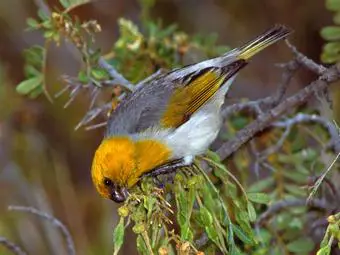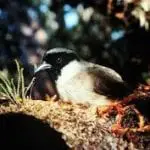Scientific Facts
| Common Name | Palila |
| Scientific Name | Loxioides bailleui |
| Lifespan | 13 Years |
| Size | 6 – 7.5 inches |
| Mass | 37.85 grams |
| Habitat | The Hawaiian tropical rainforests belt at about 3,000–4,500 feet elevation |
| Range | The upper slopes of Mauna Kea, Hawaii |
Information & Physical Appearance
![Description: Резултат с изображение за „palila bird reddit“"]()
Scientifically referred to as Loxioides bailleui, the palila is one of at least 56 species of Hawaiian honeycreepers. Out of these 56 species, about 19 have gone extinct, and the palila is currently also critically endangered with extinction.
The palila is part of the family Fringillidae, subfamily Carduelinae.
This unique, vividly colored bird is endemic to Hawaii. The head and breast are bright yellows in color. Ventrally, the plumage coloration is white to light, soft gray. Dorsally, the plumage coloration is medium gray. The iris is brown.
The wings, as well as the tail, are colored in hues of olive-green. The palila is “equipped” with a specialized, heavy bill that is swollen on the sides and is dark in color. The feet of these birds are dark, too, while the bottom of the feet coloration is yellowish.
Measuring up to 7.5 inches in length, the palila is one of the largest Hawaiian honeycreepers that still exist on the Islands.
There is some sexual dimorphism among these birds, as males often exhibit a brighter coloration overall. Also, the zone between the eyes and the nostrils (aka the lores) is clear-cut black in males. In comparison, the zone between the nostrils and eyes in females is less contrasting to the dirty-yellow colored head, as opposed to the contrast observed in males’ lores to head coloration.
Female palila birds are only slightly smaller than males.
Lifespan
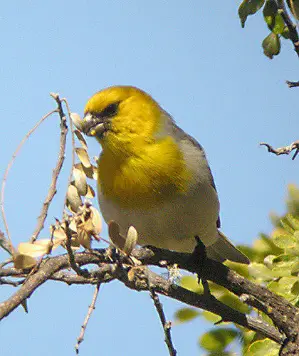
The maximum recorded longevity of a wild Loxioides bailleui is 13 years of age, according to the Animal Ageing and Longevity Database.
Ecosystem & Habitat
Nowadays, the palila is known to exclusively occupy only on the upper slopes of Hawaii, and in particular, the upper slopes of Mauna Kea. This endemic bird species lives at high elevations and is found from about 6500 to 9500 feet.
The range of this species is considered to be rather confined, and it is suggested that the range may have been always confined, as these birds do not appear to venture too far away from areas where Sophora chrysophylla, locally referred to as māmane, is abundant. Experts have further confirmed that the population density of these birds does increase in areas of the island where mamane stands are ampler.
Sophora chrysophylla (māmane), is a flowering plant endemic to Hawaii. Being a part of the bean and pea family, mamane grows as a tree or shrub, being highly polymorphic. Mamane plants are capable of reaching up to 15 meters in height when it comes to their tree forms. It is during the winter and spring when yellow flowers are produced.
Quintessentially, palila birds are distributed at elevations of about 3000 – 4500 feet in the area located above Hawaii’s moist forest belt. Hawaii’s moist forests, also commonly referred to as the Hawaiian tropical rainforests, make up a one-of-a-kind ecoregion, characterized with moist tropical broadleaf forests, covering an area of 2,600 square miles in the montane, as well as the windward lowlands regions of the Hawaiian Islands.
As the Hawaiian tropical rainforests have been isolated by vast stretches of the Pacific Ocean, ever since 28 million years of existence, this has resulted in the amazing evolution of the stunning biodiversity of a wide variety of endemic species, including birds, mosses, and fungi, among other wildlife.
The palila shares a deep, ancient, profound ecological relationship with the endemic mamane plants.
The palila is known to favor a dry forest habitat mix, consisting of Sophora chrysophylla (māmane), as well as Myoporum sandwicense (māmane-naio). Additionally, the preferred dry forest mix further contains patches of Styphelia tameiameiae (pūkiawe shrubland found on lava plains), grasslands, and nonetheless, other types of understory vegetation native to the Hawaiian Islands, apart from the forest.
Back in the 19th century, palila were still numerous and were found in abundance at elevations as low as 4000 feet. However, up-to-date the palila is only found in areas that cover less than 10% of the original historical range of these magnificent living creatures.
It was up until the beginning of the 20th century that palila birds used to be plentiful throughout Hawaii, living on the northwest slopes of Mauna Loa, the upper slopes of Mauna Kea, as well as Hualālai’s eastern slopes.
In 1944, scientists considered the palila almost fully extinct, yet it wasn’t before March 11, 1967, when Loxioides bailleui was officially listed as an endangered species, receiving protection under the Endangered Species Act.
It was in 1978, when the 9th Circuit Court of Appeals ruled the removal of feral goats and sheep from the bird’s critical habitat, especially since it was earlier in 1975 when experts estimated that there were as few as 1614 existing palila birds on the island.
Even though consistent trends are absent, annual counts executed between 1980 and 1996 estimated the palila population ranging from 1584 and up to 5685 mature specimens.
It was Mauna Kea’s west slope to contain 72% of the entire palila population occupying an area of 19 000 acres, with a population of 4396 birds, as well as population density, being estimated back in 1997.
Behavior
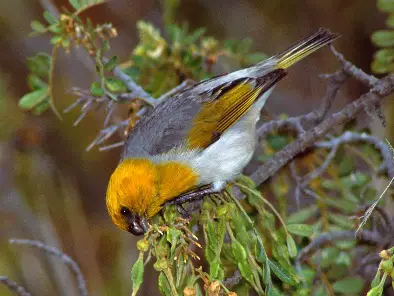
The behavior of palila birds is intricately linked with the major source of food in their diets – māmane seeds. Also, it is in mamane trees where these birds build their nests. The breeding, life, survival, and overall behavior of palila birds are all deeply related to māmane availability.
Mamane seeds are known to contain a lethal amount of quinolizidine alkaloids. These deadly alkaloids are contained within the seed embryos themselves. Furthermore, the seed coat contains a big amount of vile-tasting phenolic compounds.
The incredible ways through which adult palila birds manage to somehow cope with the otherwise lethal dose of toxins contained within mamane seeds remain undetermined up-to-date. However, it is well-known that a small dose of these toxins would kill other small animals in a matter of mere minutes.
Interestingly, as the amount of toxins in mamane trees and shrubs varies, palila birds are observed to intentionally avoid some of these shrubs and trees. Experts believe it is possible that the avoided types of mamane contain the highest amount of poisonous toxins. However, the exact means used by these birds to recognize which type of mamane trees contain the highest amount of poison as to avoid them, are not known up-to-date.
Furthermore, the bitter taste of the seed coats does also not seem to affect the birds at all. Another part of the extremely curious behavior of palila birds is that they discard the seed coats, as the seed coats are actually not very nutritious.The Palila is not only selective to individual mamane trees in which is forages, but also when it comes to those in which it nests and roosts. In general, large mamane trees are preferred.
In contrast to Hawaiian nectar-seeking birds that invade mamane forests only seasonally, Palila birds are known to live a relatively sedentary life. They tend to travel for no more than just a few kilometers away from their natal nests.
During the breeding season, palila birds travel to great lengths just to be able to obtain Cydia caterpillars.
Food & Diet
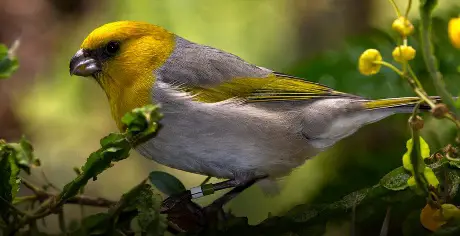
The palila’s diet consists almost entirely of the immature māmane seeds, as long as these seeds are available. The very bill of the palila is highly specialized, being perfectly adapted to opening Fabales podes, Fabales being an order of flowering plants, the same order in which mamane plants are classified.
The palila is to first hold the pod using only one of its feet to pry it open, employing its bill in order to expose the nutritious seed hidden inside. Afterward, the palila is to tear away the remaining visible portion of the seed’s coat. The bird manages to extract the seed embryo while leaving the coat remnants in the pod.
The seeds that are to drop out of the pod intact during the process of opening are successfully picked and skillfully positioned in the bill longitudinally. What follows once the seed coat is cut open neatly, thanks to the specialized bill’s edge, is that the bird uses its tongue to nudge out the embryo, while the still remaining-in-one-piece seed coat is discarded by being dropped on the ground.
Apart from mamane seeds, palila birds also feed on naio berries, as well as other fruit, like the non-native Cape gooseberry, which was introduced to the Hawaiian Islands. Other food sources in these birds’ diets include the young leaves and buds of mamane, as well as the tender mamane flowers.
Loxioides bailleui species are not exclusively herbivorous, as these birds also feed on caterpillars, yet even the caterpillars they feed on are deeply intertwined with māmane availability, since the preferred type of caterpillars are māmane codling moths (Cydia species), and the less favored māmane snout moth (Uresiphita polygonalis virescens).
It is thanks to the highly nutritious māmane seeds, as well as the caterpillars and other consumed insects alike, how palila birds manage to provide themselves the needed amount of protein in their diet. When it comes to nestlings, they are fed predominantly with Cydia caterpillars, and that’s because they are too young and immature to be able to cope with the high amount of poison contained in māmane seeds. Cydia caterpillars destroy or discard the toxins found in mamane seeds that they take along with their food, and so the caterpillars themselves are not toxic.
Cydia caterpillars are known to contain significant amounts of phenolic compounds that are thought to be sequestered from their food. The thing is, palila birds do not really seem to mind the unpalatable, adverse aftertaste of these compounds, or the birds may not be able to physically perceive this taste and aftertaste, according to scientists.
Reproduction
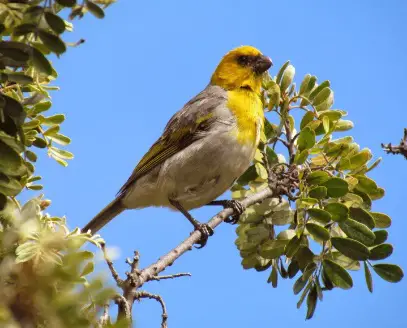
The reproduction rates, as well as adult survivors of palila birds, are both directly affected by the abundance of māmane seeds. These birds start to eat māmane seeds at higher elevations, and they gradually move downwards the mountain slopes. As these seeds become scarce during droughts, most palila birds do not attempt to breed at all.
Females reach sexual maturity once they turn one year of age, while males become sexually mature once they turn two years of age.
Breeding typically occurs from February to September. It is during this period of time when the female palila bird is to construct a loose nest shaped like a cup. The nest is about 4 inches in diameter and is built high up in a naio or mamane tree.
To construct the nest, the female is to uses various natural building materials, including stems, lichen, roots, grasses, and bark obtained from the mamane trees. The inner layer of the nest consists of small leaves and lichen.
The average clutch size is two eggs. The number of clutches per breeding season is only one. Incubation lasts for 16 days.
Males and females share parental care, as both of the parents are in charge of regurgitating food in order to feed their young. At hatching, chicks weigh as little as 2 grams. They remain in the nest for up to one month before they fledge.
Health Risks & Survival Threats
As the palila relies heavily, and almost entirely, on soft, immature seeds, as well as young leaves and nonetheless, flowers, produced by the Sophora chrysophylla (mämane, the endemic dry-forest tree growing in Hawaii), this bird species is the epitome of seed-eating specialization.
Furthermore, it is not solely on the seeds, flowers, and leaves, produced by the mamane trees that palila birds strongly and deeply rely on, since the overall lifestyle and survival of these amazing birds are intricately related with various other natural resources supported and/or produced by mämane.
Mämane availability influences the distribution, foraging behavior, dispersal, abundance, and breeding ecology of the palila.
Palila populations thrive in large patches of forest distributed along an elevation gradient.
The timing of mämane flower and seed is strongly impacted by elevation, while availability varies among trees annually. With that being said, palila birds’ food resources are available all year-round in parts of the forest extending broadly around and down mountain slopes. Loose, really small flocks of palila birds, are in charge of tracking mamane pods’ availability by traveling up and down the steep volcanic slopes.
Even though mamane seeds are very nutrient-dense, a sharp, strong bill is required in order to remove, and then rip open the fibrous pods protecting the seeds. Additionally, these seeds contain potentially toxic compounds and are eaten by very few other alien or native species, apart from palila birds.
Being the only member of the finch-billed Hawaiian honeycreepers (Drepanidinae) that has managed to survive up-to-date, as the rest of the finch-billed Hawaiian honeycreepers have gone fully extinct, the extremely close association that the palila shares with mämane is nowadays adversely influenced by different factors posing serious threats to the health and survival of the declining population of Loxioides bailleui.
Similarly to most drepanidines, palila birds only produce small clutches, usuallyconsisting of as few as 2 eggs. Moreover, both the palila embryos and the chicks alike are known to develop rather slowly, which poses higher risks to these birds’ survival, since eggs and nestlings are highly threatened by storms, as well as by predators, for a significantly longer time than most of the other small passerine species are threatened.
Meanwhile, because of the changes in climate and the ongoing climate crisis, storms, among other natural disasters, are becoming increasingly common, and hence, the survival of palila birds is increasingly threatened.
Not the least, being so strongly dependent on dry mamane forests, the palila birds’ vulnerability to fire threats is further increased, and fire threats are exacerbated by invasive, non-native grasses and other weeds introduced into the natural habitat of these birds and followed by the disturbance of ungulates.
In areas where the forest has been fragmented or truncated, which is most commonly due to cattle ranching, palila populations have been found to slowly die out.
In areas of the forest browsed by ungulates, populations have been found to disappear even more rapidly. That’s because ungulates’ preference for tender branch tips and seedlings have greatly degraded, and ultimately, reduced, extremely large areas of dry forest, ever since ungulates had been introduced to the Hawaiian Islands about 200 years ago.
In modern times, the dramatically contracted range of palila birds further leads these extraordinary animals on the brink of extinction. In fact, very few species are limited to an area that is as small in size as that of the palila. Back in time, based on evidence from fossils, the palila bird species used to occur on the islands of O‘ahu and Kaua‘I, yet live specimens are only known from Hawaii, as the populations on O‘ahu and Kaua‘I islands have disappeared before the 19th century.
As opposed to the times when the Polynesians first encountered the palila bird 1500 years ago, this animal’s range has decreased to an extremely limited area confined almost entirely on the western slope of Mauna Kea Volcano, making up for a tiny fraction of the vast range of these birds back in time.The health risks and survival threats posed to the population of palila birds are actually quite similar to those posed to other native forest birds in Hawaii, as nearly all of the endemic birds, including but not limited to the palila alone, have become stranded in the uppermost section of their historic range. There are two reasons for the native birds recently becoming stranded, namely habitat loss and the introduction of non-native, disease-bearing mosquitoes.
Fortunately, the disease-bearing mosquitoes have not yet managed to colonize the forests above 1220 meters elevation. However, in the current situation of climate emergency, when the temperatures keep rising, the deadly mosquitoes will be able to enter farther into the forests, reaching higher elevations, and hence, causing higher mortality.
The palila birds have not only lost access to much of its natural former habitat, but what’s more, it no longer has the chance to interact with the full range of native forest birds, among other species, with which it has evolved tens of thousands of years ago.
The survival and future of this species are both becoming increasingly threatened due to alien insects reducing insect prey, invasive weeds, and nonetheless, introduced, non-native mammalian predators.
Feral cats, in particular, have been found to depredate 8% and up to 11% of existing palila nests every year. Not the least, feral cats do prey on reintroduced palila, posing serious threats to the successful re-establishment of palila populations by translocating the birds. However, even though feral cats are difficult to remove from the palila habitat, there are feasible, tried-and-tested methods for reducing feral cats’ negative impact on palila birds.
Conservation
Even though there are formidable threats to the successful conservation of Palila, there are also feasible restoration opportunities. For sure, the survival and future of this mesmerizing bird species that play a vital role in a complex, one-of-a-kind ecosystem lie entirely in the hands of humans.
Fortunately, there is still hope for saving palila birds from extinction, as their ecology is actually much more thoroughly known, as compared to the ecology of any other of the native Hawaiian forest birds. Both the species and its habitat are much more amenable and accessible to field studies.
Nowadays, experts believe that the triumphant conservation of palila is much deeper related to coping with habitat loss by habitat restoration, as well as with coping with limiting factors, such as ungulates and other non-native species, rather than putting an emphasis on nesting behavior.
Furthermore, the research and conservation efforts regarding palila birds were initiated before the population declined to extremely low numbers, and before these birds’ habitat had possibly gone completely lost, contrary to the case with most other native Hawaiian birds.
Despite the substantial degree of habitat protection, the successful recovery of the Palila cannot be assured up-to-date, especially with the ongoing consequences related to climate change.
In partnership with the State of Hawaii Division of Forestry and Wildlife, the San Diego Zoo Institute for Conservation Research has managed to successfully breed palila birds at the Keauhou Bird Conservation Center. Palila breeding began in 2000, and 28 mature individuals were released into the wild, while the breeding of this species further continues with the aim of releasing more of these unique birds into the wild.
May 17, 2019, marked the peak of a multi-year effort for trying to boost the number of palila birds in the wild, as well as to prevent their extinction. It was on May 17th when palila birds outfitted with radio transmitters to help researches better track the birds in the coming months, were released. Additionally, feeding stations were placed with a mind to providing supplemental food within the release area to help the palila birds adjust to the wild easier.
The birds were housed as pairs. They were housed in separate release aviaries, and were under continuous, almost constant observation, receiving food, care, love, and attention daily.
According to Lainie Berry, a member of the Hawai‘i Forest Bird Recovery Coordinator at the DLNR Division of Forestry and Wildlife, the release of these birds into the wild is an important attempt for establishing a second population of palila birds, with the purpose of broadening their current range, since when having a very small population in only one single area, which is the case with palila birds up-to-date, puts these feathery beings are higher risk of extinction.
Other conservation efforts include limiting the negative consequences related to the way palila birds have been adversely affected by introduced predators, such as mongooses and cats, as well as habitat degradation and loss. Ungulates-triggered habitat degradation has shown to have an especially negative impact on the slow-growing native mamane trees, the seeds of which make up for about 90% of the year-round diet of the Palila.
The Pacific Cooperative Study Unit’s Mauna Kea Forest Restoration Project has been engaged in habitat management by employing predator control. Also, extensive landscape-scale restoration has been employed. For this purpose, ever since 2008, thousands of sub-alpine dry forest species, and nonetheless, mamane species, have been planted at elevations between 5000 and 8000 feet, which is much-needed to support the elevation gradient of food that palila birds heavily rely on.
The Maunakea Forest Restoration Coordinator, Chauncey Asing, states that the current release area has demonstrated a positive response to the lower densities of sheep and goats, and is a solid proof of the unique resilience of the Mauna Kea’s ecosystem.
Being one of the collaborators and funders of the Palila reintroduction project, the American Bird Conservancy has put a spotlight on the recovery of the palila population, making the conservation of these incredible birds a top priority, with ABC’s Hawaii Program Director, Chris Farmer, stating that it is “urgent” for people to do everything possible to put a stop to palila population decline, and to prevent extinction.
According to Koa Matsuoka, who is the senior research coordinator of the SDZG’s Hawaiʻi Endangered Bird Conservation Program, the thing that has greatly helped and keeps helping in forwarding the saving of the Palila is taking a “One Plan Approach,” that includes not only conservation efforts but also managed care and teamwork. Matsuoka hopes that the palila reintroduction efforts will not only help to save this species from extinction but may also turn into a model for future fight-extinction efforts.For the past 30 years, the recovery of the palila has been related to the collaborative efforts of multiple partner organizations. As highlighted by the team manager of Maui Nui and Hawaiʻi Island – Michelle Bogardus from the U.S. Fish and Wildlife Service, the successful recovery of endangered species is a “complex,” time-consuming process, however, successful breeding of palila birds in conservation, as well as the restoration of habitat on Mauna Kea have allowed experts to take the “next step forward” into saving this species from extinction.
Apart from additional releases of conservation breeding centers-reared Palila, experts have planned to translocate wild Palila birds in the following years. Interestingly, the mortality rates among translocated birds were found to be not at all significantly different than the mortality rates among non-translocated palila birds, further suggesting that translocation may be, indeed, a viable method for establishing a healthy, self-sustaining population of palila at some point in the bright future.
Since the decline of palila and the mamane forest alike has occurred for decades, the recovery will take many years, yet the first steps have been already made.
Currently, despite being very confined in size, the remaining habitat of these unique birds is actively preserved. Public access is only limited to nature trails.
Availability – Where to Get a Palila?
It is impossible to get a palila bird in the same sense as you can get, for instance, a parrot or canary. The palila bird is endemic to the Hawaiian Islands and is also critically endangered, so it is illegal to trade these birds, and/or to make any attempt to keep them as pets.
However, it is possible to admire these extraordinary living creatures in their natural habitat in the wild by visiting Hawaii’s restoration areas. In 2016, the Palila Forest Discovery Trail was opened, granting bird watch enthusiasts, nature lovers and naturalists alike the incredible chance to see the rare, critically endangered palila birds up close.
The Palila Forest Discovery Trail aims to raise awareness about the unique forest habitat and its inhabitants, as well as to raise support for non-native species control and habitat restoration.
The trail is a mile-long loop leading visitors through the unique mamane-tree ecosystem of Mauna Kea. The remote dry forest located at a high elevation used to be inaccessible until 2016.
Interesting Facts
1. The very first specimen of the palila bird to have been ever collected was found by Pierre Étienne Théodore Ballieu on the Big Island at the Greenwell Ranch. The specimen was collected in 1876, as Ballieu was the French consul in Hawaii back then. The type specimen is officially housed in Paris, at the Muséum national d’Histoire naturelle.
2. Sometimes, it is the case that the Hawaiian honeycreepers (Drepanididae) are included in the family Fringillidae, which is the true finch family. It was Oustalet to scientifically describe the palila bird back in 1877, and he was the one to name it Loxioides bailleui.
While describing the bird in print, either Oustalet himself or his printer, transposed the name of the first person to have collected the first specimen of palila bird – Pierre Ballieu – to “bailleui,” and so the scientific name for the palila bird remains forever intertwined with Oustalet’s curious typographic mistake.
3. For some time, the palila used to be united with other of the “parrot-billed” Hawaiian honeycreepers in Psittirostra. For a long time, the genus Loxioides was considered monotypic; however, the palila bird has been currently moved again to the genus Loxioides.
In fact, the native name ʻōʻū (ʻōʻū poʻopapale) is believed to most probably refer to the palila species, too, even though this name is nowadays used to refer to another of the endemic Hawaiian honeycreepers, Psittirostra psittacea, which is also critically endangered, with only 1 and up to 49 mature individuals remaining in the wild.
While the habits and bills of palila and ʻōʻū birds are somewhat similar, the color pattern differs.
4. A group of palila birds is collectively known as a “hive,” and this is also the case with any other group of honeycreepers.
5. There are existing reports of palila birds successfully breeding at 11 years of age, which is close to the maximum recorded longevity of 13 years of age!
6. It was in 1998 when the Palila bird became the very first animal in the world to have a district federal case cited in its own name, and in particular, the case cited was Palila v. Hawaii Department of Land and Natural Resources.
7. The Palila’s song contains whistles, warbles, as well as some thrilling notes, and is considered inconspicuous. However, the call is very characteristic. It is a bell-like, clear whistle, described as a “te-cleet” or “chee-clee-o” sound. The call is communicated between palila birds quite loudly, as it is used to advertise food availability during evening and morning time alike. The call is most frequently given whenever rain is to approach during the day.
How to Care for the Palila
The best way to take care of the palila is to first understand the threats that may lead to this unique bird species’ extinction in the future. Next, one needs to realize the collective responsibility that we, human beings currently inhabiting planet Earth, share when it comes to preserving the biodiversity created by Mother Nature millions of years ago.
There are numerous ways in which a person can choose to contribute to the preservation of wildlife, from spreading awareness and sharing valuable information using the power of social media channels on a personal level through taking part in volunteer programs that aim to save wildlife species on a global level.
Not the least, one can also choose to donate to conservation, whether it comes to donating free time and/or money. Additionally, one of the best ways to help save biodiversity on the plant, including the preservation of the critically endangered palila birds, is to embrace an environmental-friendly mindset and lifestyle by trying to limit your carbon footprint, as well as reducing, re-suing and repurposing various items, and avoiding fast fashion, as to cut the cord of over-consumerism in favor of sustainable practices.
One beautiful, recent example showcasing the fruit of the collective efforts of wildlife rescue community of enthusiasts is the building of the Palila Forest Discovery Trail. Thanks to the American Bird Conservancy and the Mauna Kea Forest Restoration Project of the Department of Land and Natural Resource’s Division of Forestry and Wildlife teaming up with community volunteers and sponsors, including but not limited to Laura Jane Musser Fund Environmental Initiative Program, it is now possible to visit the once inaccessible high-elevation trail where the beauty of the mamane-ecosystem can be fully experienced.
FAQ Section
What Does the Palila Look like?
The palila is one of the largest of the still existing Hawaiian honeycreepers and possesses a dark, heavy, specialized bill used to crack open mamane seeds. The breast, as well as the head of both male and female palila birds, are yellow, the dorsal plumage is white to light gray, and the ventral plumage is medium gray, while the wings and tails are olive-green in color.
Where Does the Palila Live?
The palila is a bird species endemic to Hawaii. Once abundant on the islands of O‘ahu and Kaua‘I, nowadays, the palila inhabits an extremely confined, small-sized area in the upper slopes of Mauna Kea at elevations of between 6500 and 9500 feet.
Are Palila Birds Endangered?
Yes, palila birds are critically endangered, as listed on the IUCN Red List of Threatened Species. The population trend is decreasing, with as few as 1,000-2,499 mature palila individualsstill living in the wild.
Why is the Palila Endangered?
The threats to palila birds’ survival include agriculture and aquaculture threats related with perennial and annual non-timber crops, invasive non-native species and diseases, viral diseases, human disturbance related with recreational activities, as well as the consequences of climate change, associated with droughts, temperature extremes, habitat shifting and alternation, and storms and floods.
Is the Palila a Honeycreeper?
Yes, the palila is one of the Hawaiian honeycreepers, and are very distant relatives of finches. Palia birds are the last members of the 16 species of seed-eating, finch-billed forest birds found in the main Hawaiian Islands.

